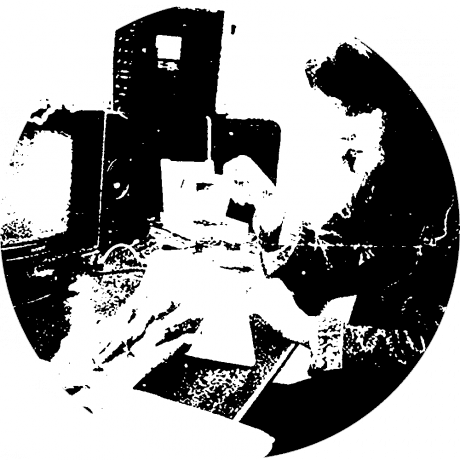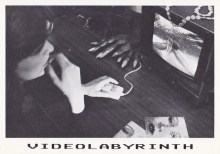Zeittransgraphie, Videolabyrinth, and Gábor Bódy
Zeittransgraphie, Videolabyrinth, and Gábor Bódy
This vital record of the time is especially urgent given the lack of archival preservation of video works produced in the period—videos were never systematically cataloged, and many students left with the original copies of cassettes. Today, looking for Videolabyrinth, for instance, yields no entry in the dffb archive, and metadata is missing. Beyond the particular idiosyncracies of any institution, this lack of nearly a decade of findable electronic art from the dffb history points to a larger question about how to locate and catalog experimental media art, especially from turbulent times. Anders’ personal written story is therefore an urgent call for archival efforts and also constitutes an important piece of evidence itself.
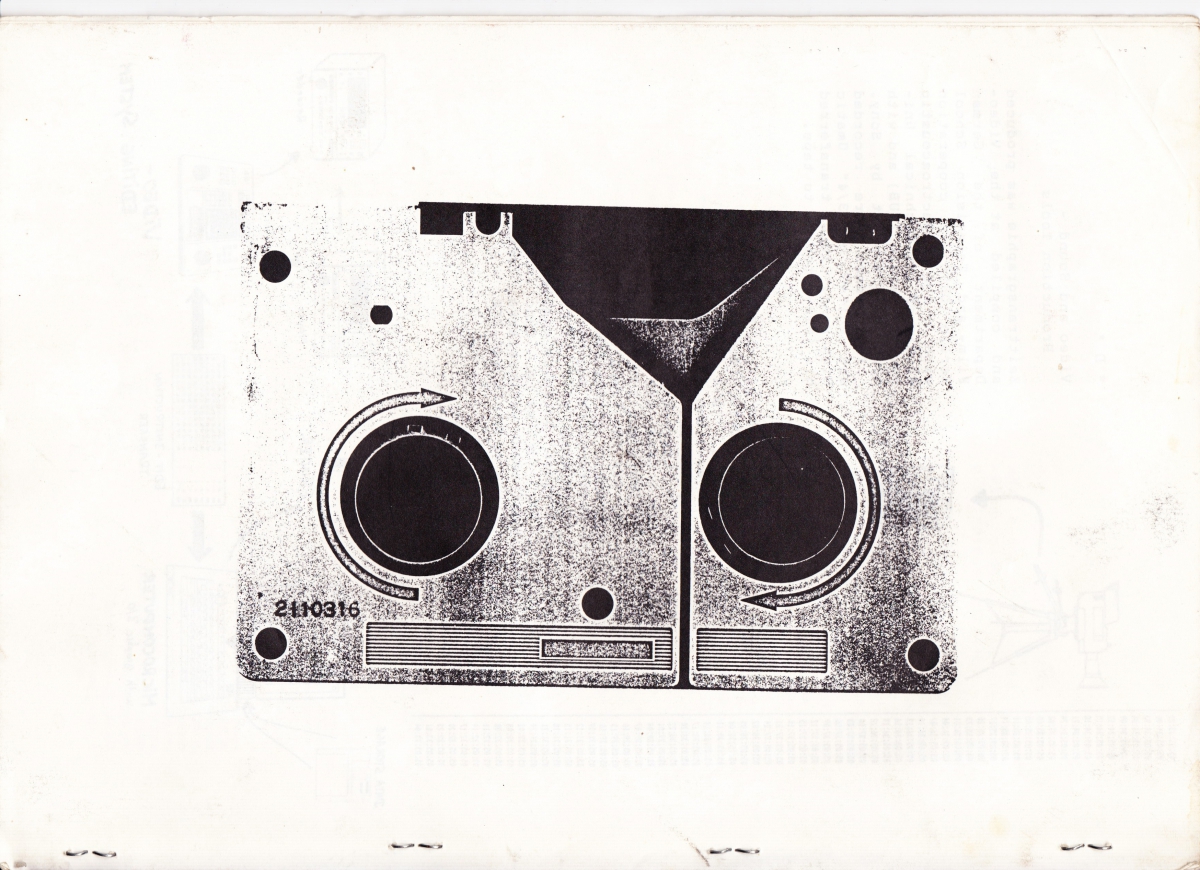
The arrival of “New Media” at the dffb
Back when the West Berlin subway still crossed through ghost stations beneath East Berlin and student neighborhoods smelled like coal in winter, none of us could have dreamed of the “Wende” that would arrive in less than five years.
The Deutsche Film and Fernsehakademie (dffb) was on the fourth and fifth floors of the Deutschlandhaus at Theodor-Heuss-Platz in West Berlin, near where Kaiserdamm becomes Heerstraße, with a direct view of Radio Free Berlin’s (SFB) neon sign. While people were sleeping, dancing at Dschungel, or hanging out at Risiko, some students at the dffb were able to work right through the nights thanks to a 24-hour concierge service, a service that users of Room 546—the high-band video editing room—made extensive use of.
For a while there had already been films being made at the dffb that were conceived neither for cinema nor television. Instead, they were—inspired by punk—oriented towards music (sampling) and visual art (Dadaism, Situationism). The creators of these works not only wanted to decipher the language of cinematography but also to deconstruct and rebuild it—if not necessarily in a chronological, linear way.
This anti-narrative interest wasn’t limited to video—films like Flug durch die Nacht (1980) by Ilona Baltrusch and Okay Okay: der Moderne Tanz (1979/80) by Christoph Dreher and Heiner Mühlenbrock were made on sixteen-millimeter film. But during that same period, a pioneering video work was produced and presented as an installation on two monitors: Seisn–Fiction (1980) by Gusztáv Hámos. It was about space travel and the great beyond; the actors appeared in West Berlin subways that passed through ghost stations.
The switch to electronic media at the dffb was not originally attributable to fashion or commercial technology hype. The main priority was the deconstruction of the tired representation formulas of creating “spectacle” by any suitable audiovisual means.
For those interested in “recycling” found (TV) footage, which was strongly advocated by, for example, Christoph Dreher and Gusztáv Hámosz,1 video became the medium of choice.
The artistic video works that were subsequently created at the dffb received very positive responses. In the 1980s, they were shown at exhibitions and festivals across the world, they were featured in the international video art magazine Infermental, 2they were discovered by television editors, and they were discussed by critics abroad, who coined the term “Berlin School of Video,” or “L´Ecole de Berlin” 3 for this particular style of video-art.
However, they were hardly able to reach a sympathetic public at the academy, and the dffb only partially succeeded in officially archiving the U-Matic master tapes for posterity. This is why today these films are unfortunately hard to find, and playing those that are left has become technically difficult.4
Why, then, did the students opt out of the academy’s day-to-day to spend long nights wrestling with analog editing machines? Why did they surrender their works to a technology with such low resolution, poor color fastness, and severe copy degradation, which was so obviously impermanent?
I still remember that the impermanence and instability of the signal and the magnetic particles held a peculiar charm for us.
The shortcomings of video imposed a distance from the pictorial object, exposing the structure beneath it and emphasizing its rhythm. A second-generation editing interface allowed for serially programmed sequences that could be carried out virtually—via an electronic preview—without physically changing the material.
The approach seemed to correspond exactly to the immaterial “flows” and “intensities” that Deleuze and Guattari suggested were “rhizomatic” and “nomadic.”5 It also implied a freer access and less respectful treatment than was possible with photochemical film, which always had to go to the lab to be permanently fixed. And we were not completely unimpressed by the rampant techno-optimism of the time—even as census opposers and television haters, we were caught in its grip. The promises of the dawning “telematic society” (Vilém Flusser) were, in any case, huge.6
Everywhere, there was talk of the “renaissance” and “liberation” of the spectator, the medium, and even imagination itself. Even the more critical media prophets assumed that future “envisioners” would not be filmmakers in the old sense, but would instead be computer artists.7
The director of the dffb, Heinz Rathsack, did not want to be left behind when the new media were introduced.
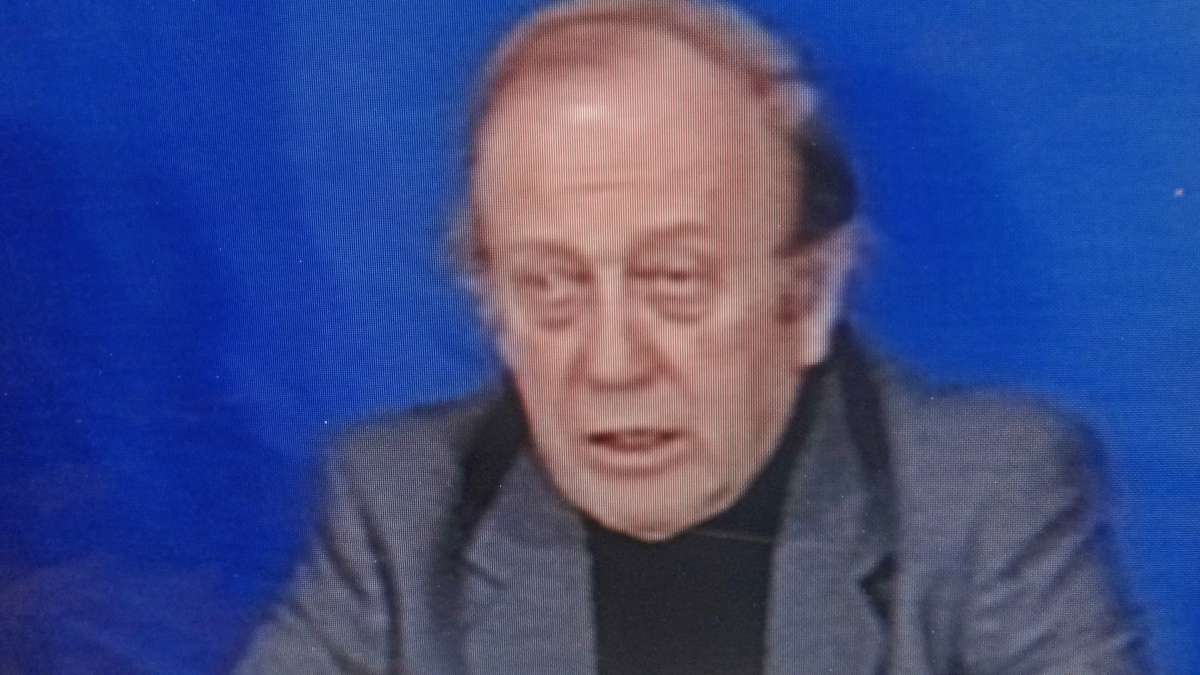

As his comments during a discussion at a three-day seminar on special effects at the dffb in Feb 19858 reveal, he was urgently interested in countering the technical and organizational advantage held by the University of Television and Film in Munich. Roland Emmerich had been causing a stir there with his final project film, Das Arche Noah Prinzip (1984), and another Bernd Eichinger production, Die unendliche Geschichte (DE 1984), was even being considered the last word in German special effects craftsmanship—an assessment shared by no one in the dffb’s Room 546.
Perhaps in order to shift the content focus, Rathsack did not only invite two venerable special effect masters, Theodor Nischwitz and Albert Whitlock, but also brought in the Hungarian filmmaker Gábor Bódy as a surprise guest.
Nischwitz had already had a hand in Münchhausen, Amphitron, and Raumpatrouille, and Whitlock had painted deceptively real backgrounds on glass for many Hitchcock films.

Bódy was known in the West for his magnum opus Narziss und Psyche (1980), as the “Hunagarian Andrei Tarkovsky,” even though he was both much more poppy and mystical—with disconcerting leanings toward the occult—and more interested in semiotics than Tarkowski. In 2008, Ulrich Gregor named Bódy one of the most radical and innovative reformers of European cinema.9
In 1982, when Bódy was living in West Berlin for a DAAD scholarship, students Christoph Dreher and Gustáv Hámos—who, thanks to owning a third of the vote, were able to have an influence on the teaching program10 —persuaded him to come and lecture at the dffb.
From then, Bódy was the one chosen to breathe new, electronic life into the panel. But it wouldn’t happen until the third day of his seminar.
For the first two days of the seminar, Theo Nischwitz and Albert Whitlock had ample opportunity to give detailed, anecdotal accounts of their special effects techniques, using examples like Hitchcock’s The Birds (1963). It was great film history and was highly praised by the moderator, Rolf Giesen.
But when it came to the future of special effects, Whitlock had a conservative view: it was nothing more than a craft, and art had no business here. “Never let art interfere with it! Art gets in the way—realism is what wins an audience, and story is what defines content!”11
It was a statement that gave Bódy the opportunity to assert, with a provocative smile, the absolute opposite.
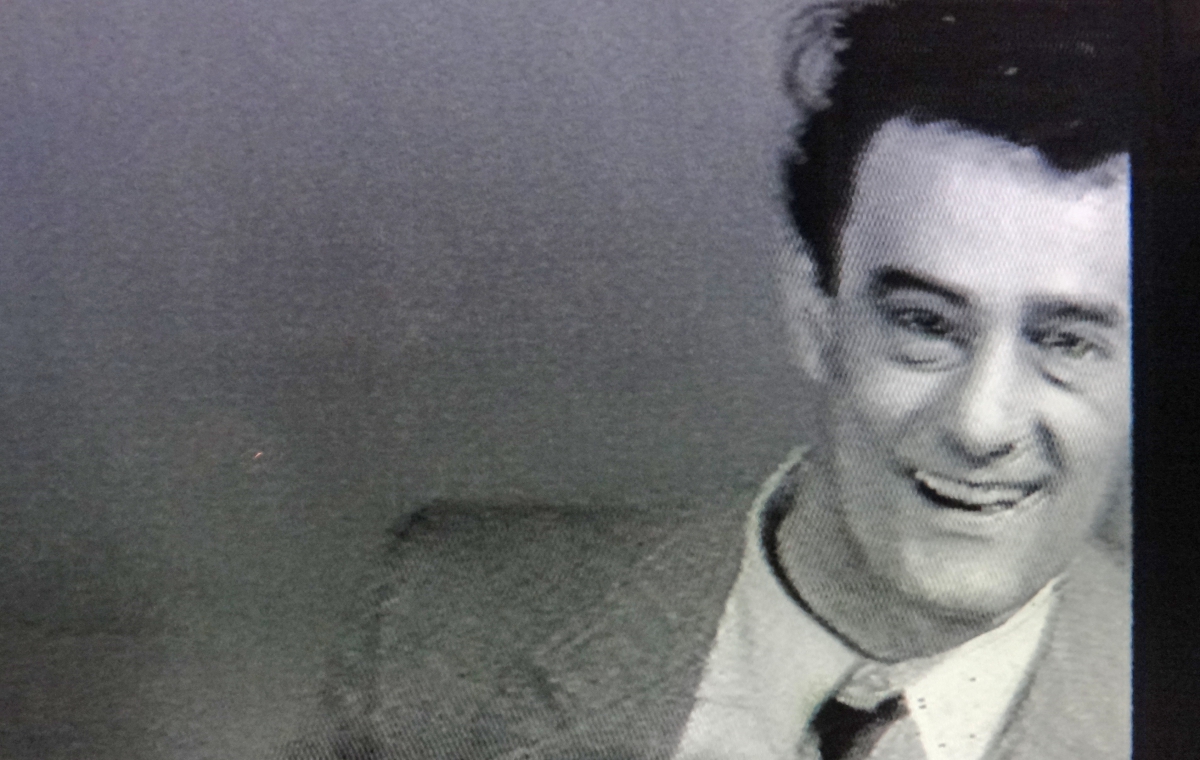
Bódy explained that he understood the concerns of Whitlock, but he wanted to play devil’s advocate and defend the new technologies, especially in their capacity as tools for artists.
He was enthusiastic about future digital images in which each individual pixel would be programmable. He predicted that high-performance computers would quickly become cheaper and soon be available to the low-budget, artistic demographic, for whom he foresaw a great task ahead when digital video finally enabled a “total liberation of the imagination.”
Above all, he emphasized that he considered it dangerous to regard the content of an artwork exclusively as “story”:
“We know this from art, [from] other forms of art, that a work of art can have content without telling a story [...] Cinematography [has been] a language and tradition for communicating things with moving images since the ancient Greeks, since the Renaissance, when there were already cinematographic phenomena. […] The tradition of narrative film developed [within] the framework of the cinematographic tradition. And although narrative film has reigned for the last eighty years, and may continue to dominate in some form, it would be a grave mistake—particularly for a director of the Deutsche Kinemathek Foundation! […] to identify the concept of cinematography with that of narrative film.”12
These remarks really struck a chord with me and other fans of the non-narrative video clip format13 and he ended up sort of recruiting us for a production that would soon begin.
None of us, however, could have imagined that Bódy himself might not even experience the liberation of imagination. His enthusiasm was contagious, so we were utterly shocked to learn just six months later that he had been found dead in Budapest. Suicide, according to the authorities. The exact circumstances and cause of his death remain unexplained to this day, despite much speculation. The fact that Hungarian film historians have suggested that Gábor’s collaboration with the Secret Police may have played a role14 makes it neither clearer nor easier to bear.
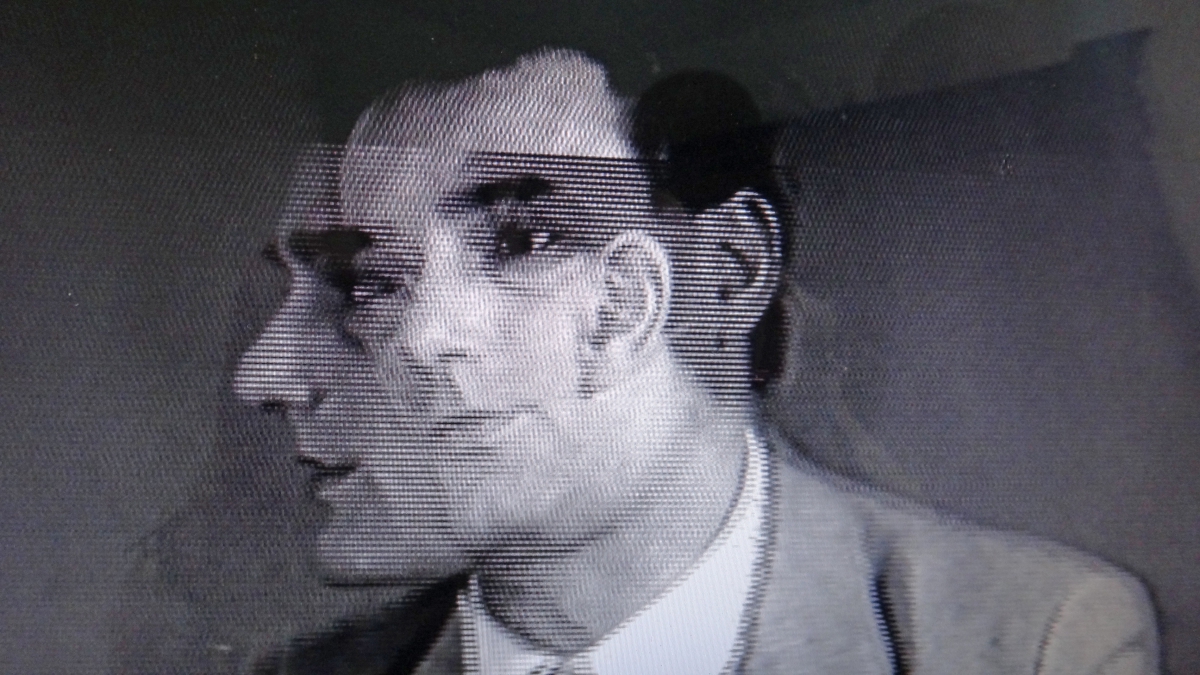
If, as students, we had heard of Bódy’s possible secret service associations when he was still alive, we might have seen it as easily excusable, in light of the insurmountable wall between East and West, and given that we were unable to imagine anything more realistic 15 than, for example, the adventures of Lemmy Caution in Alphaville.16
Without the realizing the possibly tragic dimension of our lecturer’s secrets, we were fascinated and challenged by the mysterious aura of the techno-occultist subjects that he had proposed for our production seminar.
Zeittransgrafie

For the start of the seminar in early 1985, Bódy had turned up to the dffb with a thick book under his arm, and the mathematics teacher and mailbox enthusiast Martin Potthoff as a video expert at his side. The book was De Occulta Philosophia: Libres III (1533) by Heinrich Cornelius Agrippa von Nettesheim (1486–1535), the alchemist, heretic, and inspiration for Goethe’s Dr. Faust (1808).
Bódy had recently made a short video of the same name with Llurex (Egon Bunne) and Folkmar Hein from the electronics studio at the Technical University Berlin (TU) in which he himself, silhouetted by flashes of flickering green laserbeams, appeared as Agrippa.17
For the dffb seminar Computer-assisted Image and Sound Composition (1985/86), with Martin Potthoff and Folkmar Hein, he proposed feeding the electronic editing interface (Sony BVE 800) with number sequences from the magical quadrants of this Renaissance mage. A central role in this alchemical undertaking was assumed by the timecode, which assigned a number to each and every individual video sound and image.
According to Bódy in 1985:
“It is to do with a desire that was already present in Bauhaus, where the light-organ experiments were known. It is the desire to create the soundtrack and image using the same principle […] The combination of possibilities between sound and image with electronics, using the timecode-system, is one of the most radically modernizing in the whole audiovisual language […] the timecode can be used to program specific structures as musical structures, simultaneously programming in the image editing system and the synthesizer. This code then produces a visual image and a piece of music or sound.”18
After sharing these insights, Bódy left. And none of us knew that we would never see him again.
In cutting room 546, Georg Maas, Stefan Schwietert, Tania Stöcklin, Anka Schmid, Thomas Schunke, Ika Schier, Egon Bunne, Manfred Hulverscheidt, and I, Friederike Anders, got to work.
As Martin Potthoff wrote later, the technical realization of Bódy’s ideas was no simple matter: “Our expectations were so high; the systems that could have helped were so far away. The simplest tools had to first be defined and created.”19
While some of the group worked more on the acoustic part of the experimental set-up with Folkmar Hein and his Synclavier at the TU, others worked with Martin Potthoff using a notation system from Hungarian animation artist Ágnes Háy. The system enabled frame-synchronized scores to be written for temporal movements between the axes of real time/raw material and effect time/cuts.
Between the x/y coordinates of the system a continual sequence in real time is represented by a straight line with a 45-degree incline to the upper right, a time sequence in reverse appears as line declining at -45 degrees, a steeper line shows a time lapse, a flatter line shows slow motion, and a horizontal line is a freeze. Jump cuts, staccato cuts and absurd time stretching, ellipses and compressions could be noted in the same coordinates. With the help of software programmed by Martin Potthoff, these motion scenarios could be represented as “jump values” and “length values” from which an editing list could be automatically generated in CMX format after inputting an initial time code.
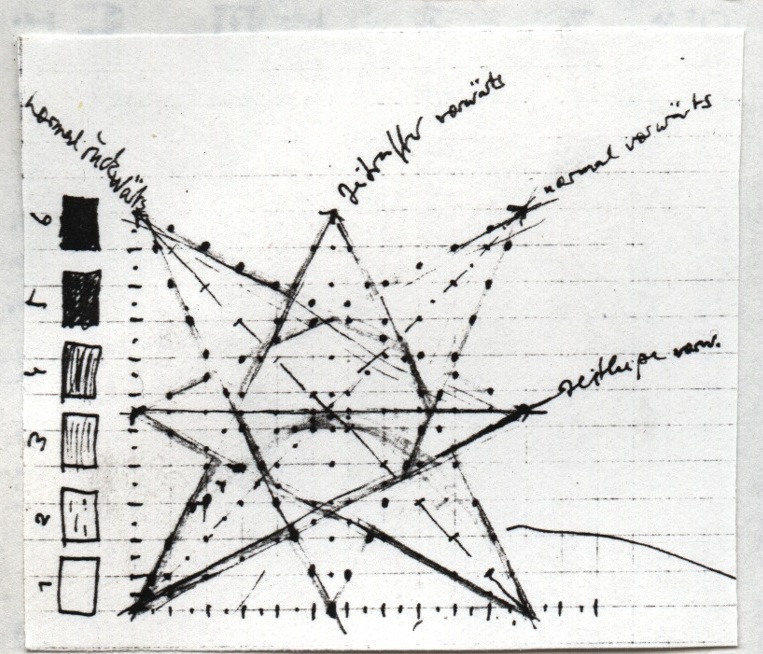
This allowed us to transfer graphic-ornamental timeline scores to the editing computer, which, by using the smallest possible units of time—25 frames per second—enabled a complete pulverization and re-synthesis of continuous sequences—amazing!

Perhaps Bódy had something else in mind originally, but this control of individual images was as close to his idea of manipulating every single pixel as it was then possible to do with analog video. But there was something else that still fell far short of our high-tech dreams: on the PAL system, the forcing of frame-specific cuts resulted in image and color distortion at the edit points, something that could only be corrected with another copy using a time base corrector.20
So, our video-time-machine started eating up all of our precious and strictly limited editing-room time. We were so busy with our tape machines—which didn’t really reliably cut automatically—we had no time to study film history. If we had, we might have noticed how close the rhythms of our cinematic time structure were to the ecstatic single-frame-cut scores of Dziga Vertov and his wife and editor, Elisaweta Svilova.
Eventually we produced, in spite of all the hardships, a series of astonishing single-image sequences that we called Zeittransgrafien (time transfigurations); and the more beautifully we were able to reverse and dissolve temporal processes in our collaged timelines, the more sure we were that we were leaving behind the oppressive logic of narrative continuity.
When the shocking news of Bódy’s death reached us, we agreed that we should finish the sampler anyway, and to exhibit it. It felt as though we were working on his legacy.21
For the 1986 Berlin International Film Festival, we put together eight video clips that ranged in style from mythic-ritual (Rondo Gravitat, 1986, by Tania Stöcklin/Anka Schmid), to John Cage-like structures (Ironland, 1986, by Llurex) to comic-documentary (10 ¾ Zoll, 1988, by Georg Maas).
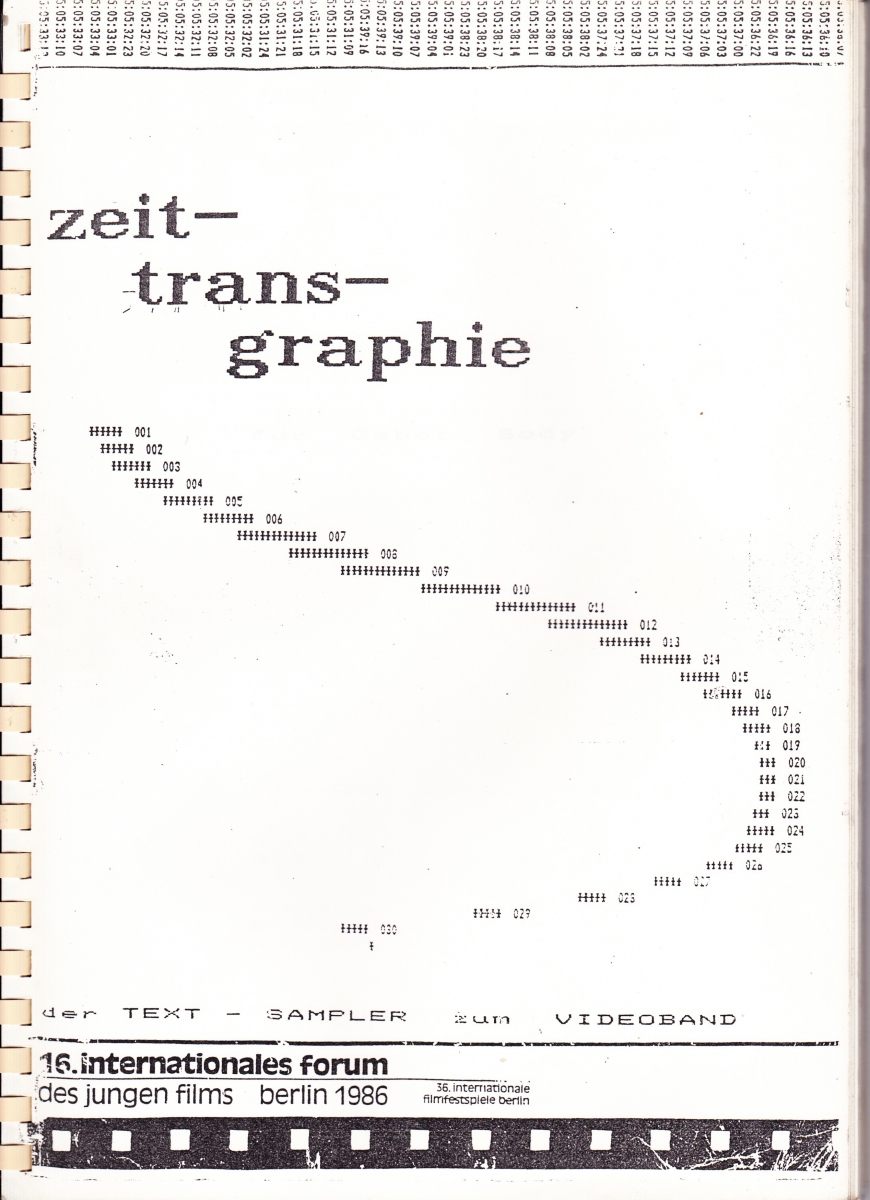
The videos in the collection all had in common that they were somewhere between perception-physiological research and established, real world observations of the phi effect, 22 which synthesized the Vertov interval 23 as a pacing clock.
Bódy’s death meant our structuralist and postmodernist style exercises unexpectedly confronted a very real hereafter. And as a result, as he had perhaps wanted, our series of numbers had turned into incantations, as in Cornelius Agrippa. Our time reversals and connections had now manifested concrete notions of time travel and ways of overcoming finitude, and it was as if a new, unknown space had opened.
Videolabyrinth
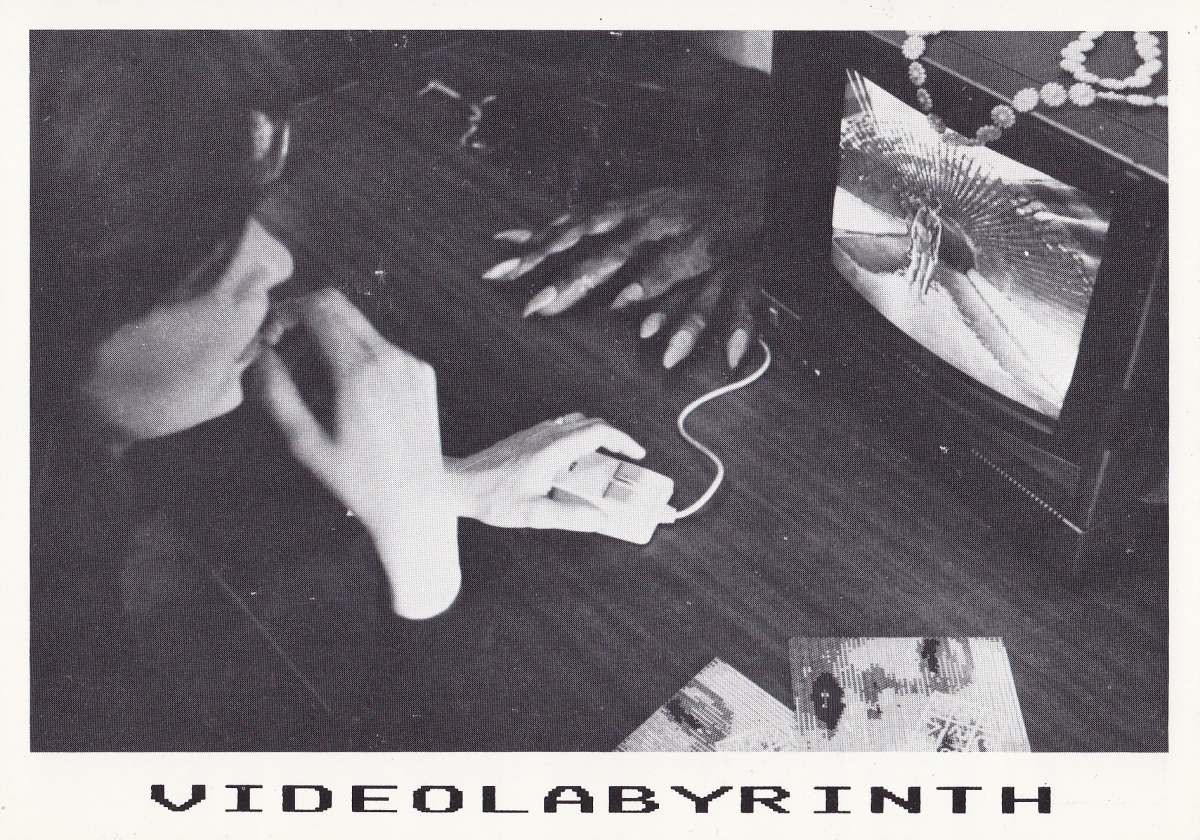
In his contribution to the discussion during the Special Effects Seminar, Bódy had mentioned yet another media utopia: the interactive videodisc, which, as an artist’s medium, had caused astonishment in the US and at Ars Electronica in Linz in 1984:
“Another possibility and a totally new path for special effects is the interactive videodisc. Products already exist and research is ongoing. I don’t know whether you are aware of, for example, the interactive map of Boston. It is currently being produced on such an interactive disc, which means you can find every single street and every single house on this disc […] Even in the houses, you can go inside and say: the sixth floor! […] the viewer can choose what areas they would like to see [...] Without doubt: in the future, there will still be huge interactive possibilities here, also for the artistic imagination.”24
From 1986 until the end of our studies in 1988, we applied ourselves to realizing this vision as well—with lecturers Martin Potthoff (again) and Carl-Ludwig Rettinger, who was then the commissioning editor of the Kleinen Fernsehspiels at ZDF.
Just as Bódy wanted to further develop the language of cinematography, Rettinger wanted to expand the possibilities of television. In his opinion, though there were lots of new stations, television was still essentially pouring old wine into new wineskins.
He saw an alternative in interactive videodiscs, which seemed to have become a popular entertainment medium in the US. Here was a chance to let viewers interact directly with the action, like protagonists in the story. Exactly what the seminar should also achieve.
In Rettinger’s words: “[Our interest is] the dramaturgic balance between elements of cinematic tension and playful interaction possibilities. Even the way viewers identify with the protagonists in the narrative is completely new in interactive systems, since the viewer is simultaneously a player and co-director.”25
What Rettinger could not know when writing his press release was that the picture laserdisc, which in 1986 was still being promoted at Ars Electronica, would never catch on in Germany, and that only today, thirty years later, with HTML5 and Quicktime video (or even with a game console and 3D glasses) have the technical means that would allow appropriate implementation been established.
And so it happened that no sponsor could be found at the time for the videodisc project. Our three “game films” for Videolabyrinth (1987-88), which were shown at festivals and exhibitions in England, Istanbul, and Japan between 1987 and 1991, were presented everywhere as Video8 copies.

Videolabyrinth contained three paradoxical “choose your own adventure” stories: “Terra Z” by Ilka Lauchstädt, “Mutabor 3” by me, and “Oberschenkelhals-und Beinbruch” by Mari Cantu.
With a scene catalog of thirty to sixty minutes, each of the three films was stored on a separate video-8 cassette, which could then be controlled via a PC program. It allowed multiple-choice selections for different versions of the story, and each game could end with a different outcome. An invitation to try out the film again from the beginning was then displayed — the content was changeable via the viewers’ selection.

A reviewer described the experience of the “game films” like this:
“Berlin’s Videolabyrinth filmmakers—Rike Anders, Ilka Lauchstädt and Mari Cantu [...] have produced an odd and intriguing hybrid: feature length videos reminiscent of arcade video games in the way they call on the viewer to control the action, but with a content that is, in the manner of Eugene Ionesco, at once satiric and surreal. [...] What’s most exciting about these videos is the concept of narrative that’s employed—not the conventional timeline moving from beginning to middle to end, but, rather, a net of interconnecting possibilities.”26
Following the player’s choice, the IBM XT PC instructed a video recorder to go to the corresponding point on the tape. In the worst case, a sequence of play could be interrupted for several minutes during which only the whir of the tape rewinding could be heard.
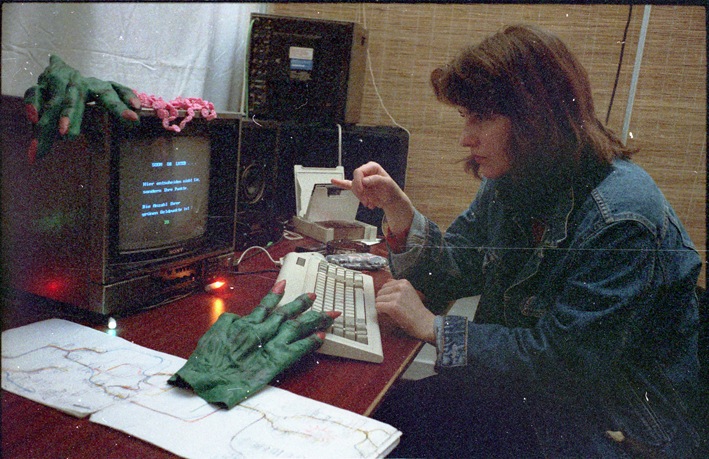
It turned out that each game required the presence of an individual visitor-support person anyway, because someone had to switch back and forth between the three programs, changing the tapes and rewinding them back to the start position before each game.
So we started to chat with our audience during these breaks. And we optimized what is today called User Experience (UX). We added intermission graphics with yet more multiple-choice questions, also with “automatic” evaluations of player behavior in the style of the personality tests found in women’s magazines at the time (“Are you type A, B, or C?”). The type descriptions came with advice and recommendations for the viewer/player: “You should go home and drink a warm glass of milk” (in “OSHUBB”), or “You’ll never find the time tunnel entrance like that! Spend more time in shopping malls.” (“Mutabor 3”). Irregular behavior was rewarded in all three games and the point system we used was simultaneously an object of our mockery.
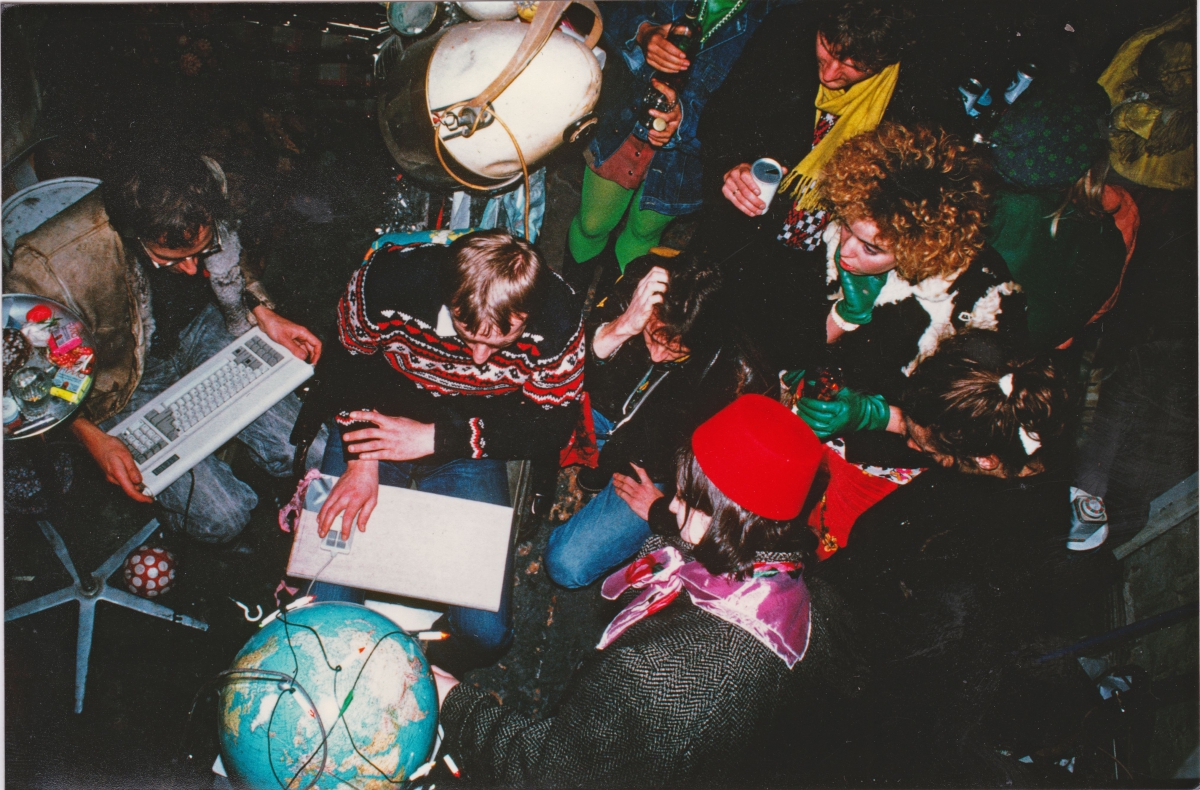
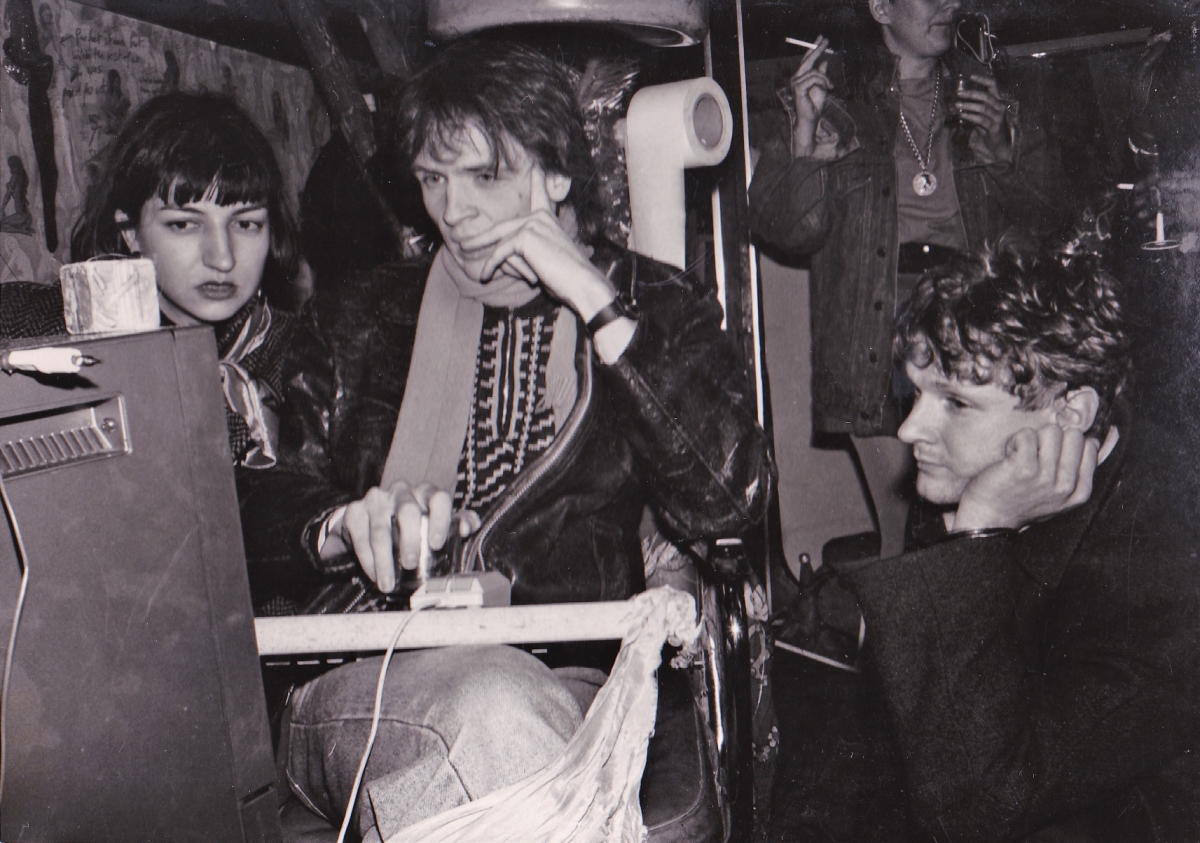
In spite of our ironic distance, we were getting a playful introduction to gathering metadata with our analysis of viewer behavior, which we would never have set out to do as opponents of census taking and data monitoring.
But, paradoxically, it was essential for a truly interactive user experience. The “free” decisions made by the players about the progression of the story could only be fulfilled when a lot of user data on previous game behavior had been evaluated, so that viewed scenes could be excluded and only the most interesting upcoming scenes would be suggested.
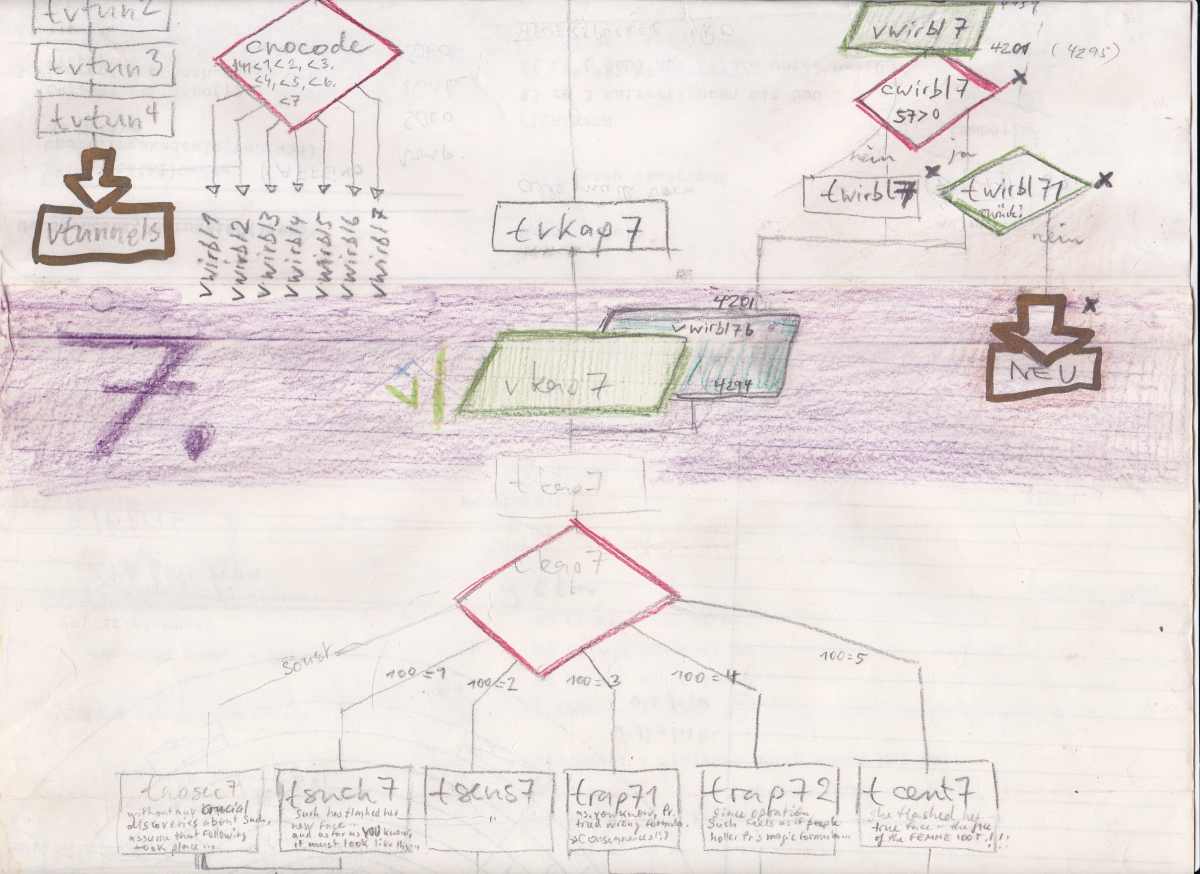
Many of our fellow students found our activities suspicious. They happily accused us of using a by-product of Ronald Reagan’s Strategic Defense Initiative (nicknamed “Star Wars”) to make our colorful video and computer technology. Didn’t our longed-for laser videodisc player depend on the same technology as the laser weapons that Reagan wanted to send into space? And didn’t the powerful computers we needed come onto the market only because they had been developed for the SDI?
But we, in contrast, ascribed to Friedrich Kittler’s idea that all media are a result of war. We countered, no less polemically, that our fellow students were being subordinated by doctrinal narrative logic with their linear films, which kept the audience ignorant and unfree.
It seems to me today as though we were talking entirely past one another.
In one way, with our structuralist editing experiments we were applying timeline manipulation as described by philosopher and media theorist Friedrich Kittler (1943–2011) in 1993.27 Our experiments were also grounded in the classical tradition of experimental film and were thus very far removed from the colorful MTV aesthetic that seemed to resemble our work in a superficial way.
On the other hand, our playful experiments with user tracking were, from today’s perspective, actually quite perfidious features that pointed far into the surveilled, networked future.
But if a video-skeptic ex-classmate suddenly asked me today, in the face of the ever-increasing use of our data online and the simultaneous monopolization of information and entertainment channels, whether we foresaw it all, I would have to say no.
We were just researching and applying non-linear narrative and interactive dramaturgy, nearly thirty years before they became everyday, thoroughly commercialized online instruments with cookies, universal user IDs, and search engine optimization.
And we were, of course, inspired by a real devil’s advocate, whose master, as is known, “always wills the Bad and always works the Good”28 —and who is probably quite at home in the NSA headquarters today.

- - - -
I would like to thank Madeleine Bernstorff, Gusztáv Hámos and Martin Potthoff for their support in the development of this text. Without the valuable discussions, translations, memories, and documentation it would never have been as rich or as well documented.
- 1. “Raw audiovisual material is a sound/image element freed from its original context, and as such it is available for [...] further processing.” Christoph Dreher, “Scheiße zu Gold. Zu einer Ökologie des Audiovisuellen,” in Gábor Bódy/Veruschka Bódy (eds), Video in Kunst und Alltag. Vom kommerziellen zum kulturellen Videoclip (Cologne, 1986), 15.
- 2. Infermental was the first international video art magazine on video-cassettes. Initiated by Gábor Bódy and Astrid Heibach, the first edition, “Infermental Berlin I,” was published in 1980.
- 3. “Gusztáv Hámos belongs to the so-called “Berlin School” [not to be confused with the film movement of the same name that was attributed to the dffb in the 1990s], along with Vidéasten Ed Cantu, [Katalin] Pazmandy, [Rolf S.] Wolkenstein, [Monika] Funke-Stern, etc. They all play with the codes of film and television—in a form that pushes the clip-aesthetic to the extreme: reducing the action to its most “powerful” moments, replicating supporting roles, playing with the heterogeneity of the décor [...] Blending different levels of representation, working with very short, dense scenes—all in the service of a plot that comes across as simultaneously parody-like, hollow, and mechanical. And it is perhaps less a parody of cinematic code and more a parody of the clip, a parody of the parody. For video makers of the Berlin School, the images of cinema had already merged fully with television.” Colette Dubois, Marc-Emmanuel Mélon, and Philippe Dubois, “Cinéma et vidéo: Interpénétrations,” in Comunications, Vol. 48, No. 48 (1988), 135. Trans. Janet Leyton-Grant.
- 4. Gusztáv Hámos began collating a list of missing seminar and final project films in 2015.
- 5. Maurizio Lazzarato summarizes Gilles Deleuze and Felix Guattari’s ideas on this matter as follows: “The electric current … may be exemplary of a technical means of expression corresponding to the general deterritorialization of capitalist flows … Accordingly, all images produced with electronic and digital technologies are transformations and combinations (compositions) of intensities, forces, and fields taking place in the current. Electro-magnetic current in the case of video, optical current in the case of telematics, and algorithmic current with computers. The transition from the first to last could be defined as an increasing force of deterritorialization.” Lazzarato, Videophilosophie: Zweitwahrnehmung im Postfordismus (b_books, 2002), 87, footnote 1 (trans. Janet Leyton-Grant)
- 6. Vilém Flusser, Into the Universe of Technical Images, Trans. Nancy Ann Roth (University of Minnesota Press, 1985).
- 7. “Computers offer us the opportunity to create a vast array of new worlds. [...] It is crazy not to use new creative technologies, they produce, as it were, creativity.” From: “All Revolutions are Technical Revolutions: Vilém Flusser im Gespräch mit Florian Rötzer,” in Ästhetik des Immateriellen? Zum Verhältnis von Kunst und Neuen Technologien, Part 1. Kunstforum International, Vol. 97, November/December 1988, 127, 131.
- 8. Video documentation of the Special Effects Seminars in February 1985 at the dffb. In Deutsche Kinemathek Archives 33, 34, 35, 185; particularly 35: “Special Effects, Whitlock: How to make matte-paintings.”
- 9. “Bódy Gábor (1946–1985) is one of the most outstanding and unusual personalities from the Hungarian and European cinema of the 1970s and 80s—multi-sided, fascinating and dazzling. He belongs to the group of radical and most daring innovators of our time.” From: Ulrich Gregor, “A source of interesting discoveries,” Bódy Gábor.hu.
- 10. “The third-party parity representation rule states that all internal concerns of the dffb should be discussed and decided by the Academy Council. Paragraphs 5 and 6 of the dffb statutes, which are still valid, are worded as follows: “The Academy Council is comprised of the director, the director of studies, the production director commissioned by management with coordination for the current financial year, two lecturers and one assistant lecturer who has been working at the dffb for several years, and three students, with each year of study being represented. […] The Academy makes decisions in meetings only and, insofar as the statute indicates, by a simple majority of members present. In the case of a tied vote, the issue must be resubmitted to vote after consultation; in the case of a repeated tie, the chairman shall have the deciding vote.”
- 11. Albert Whitlock, from video documentation of the Special Effects Seminar in February 1985 at the dffb. Deutsche Kinemathek, Archive no. 35 (unedited), 185 (edited).
- 12. Bódy, from documentation of the Special Effects Seminar at the dffb. Deutsche Kinemathek, Archive no. 185 2/2.
- 13. The term “clip,” meaning short, arty films was based on MTV’s music “clips,” so beloved at the time. They were described as a “cultural clip” by Bazon Brock in Veruschka Bódy/Gábor Bódy: Video in Kunst und Alltag. Vom kommerziellen zum kulturellen Videoclip, (1986), 9.
- 14. Apart from in the two books published only in Hungarian (Fedöneve: “szocializmus” Müvèszek, ügymökök, titkoszolgák and Titkos írás: Állambiztonsági szolgálat és irodalmi élet, 1956-1990", Tamás Szőnyei, 2012), this issue was also reported in a very interesting German essay by László Beke that discussed Bódy’s art and secret service activities: “Gábor Bódy. Netzwerker,” in the exhibition catalogue of “Der Stand der Bilder / Die Medienpioniere Zbigniew Rybczynski und Gábor Bódy,” Siegfried Zielinski and Peter Weibel (Eds.), 2011.
- 15. That an East-West cultural dialog such as that valued by Gábor and Heinz Rathsack had to have some kind of price in during the Cold War seems glaringly obvious to me today. West Berlin as the hub of the cultural Cold War has been described in rich detail in, for example, Frances Stonor Saunder’s Who paid the Piper? The CIA and the Cultural Cold War (Granta, 1999). Bódy himself preferred to make fun of it; in the middle of the period he was supposedly active in the secret service. In a three-minute video from 1978, “Dialogue between East and West,” made with West German video artist Marcel Odenbach, the two sat side-by-side with nameplates, like guests on a talk show, and presented an incomprehensible dialogue that involved frothing at the mouth.
- 16. Alphaville, Jean-Luc Godard, 1965.
- 17. According to the description of Bódy’s Philo-Mytho-Lyric-Clips on media archive LIMA: “Inspired by De Occulta Philosophia, a magic manual written by Agrippa von Nettesheim, the 15th century occult adept. Bódy depicts an outline of the relations of the human body which is combined with elliptical light signals that pulsate and are driven by synthetic bursts of sound. A figure appears. The alchemist who was once von Nettesheim, now finds his expression in and through Bódy.”
- 18. Bódy, from documentation of the Special Effects Seminar at the dffb. Deutsche Kinemathek, Archive no. 33/ 6/6 and 85 2/2. Trans. Janet Leyton-Grant.
- 19. Martin Potthoff in “zeit-trans-graphie—der TEXT-SAMPLER zum Videoband,” the program brochure for the screening at the 1986 International Forum for New Film at the Berlinale. Trans. Janet Leyton-Grant.
- 20. Time base correction was a true harbinger of the digital age in the editing room. While the preview function of the electronic interface was still dependent on an analogue switch between the player and the recorder, time base correction offered the ability, for the first time, to digitally save and edit entire frames of video images in real time.
- 21. As Martin Potthoff recalls, the completion of the seminar after Bódy’s death was only possible with the intervention of the director, Heinz Rathsack. While student administration wanted to cancel, Rathsack wanted to turn the study outcomes into a presentable product. He provided the necessary resources himself, and even bore the cost of a flight to Bódy’s funeral.
- 22. The phi effect, phi phenomenon, or motion illusion is the sense of apparent movement in stroboscopic sequences of spaced light flashes or still images that is caused by persistence of vision in the brain.
- 23. The gap or interval between single visual impressions in Vertov’s work on cinematic grammar is hugely relevant to montage effects. Because he valued the impact of this interval so greatly, he even labelled a hall in Moscow in its honor.
- 24. Bódy, from documentation of the Special Effects Seminar at the dffb. Deutsche Kinemathek, Archive no. 33/ 5/6 (unedited), and no. 185 2/2 (Mastercut Bluebox).
- 25. Carl-Ludwig Rettinger, press release for Videolabyrinth from 1987. Trans. Janet Leyton-Grant.
- 26. Garth Pritchard, “Viewerismo,” Elle, May 1990.
- 27. “Time axis manipulation under the condition of the monopoly of writing excluded everything that [...] is known as the noise of the real. You can take the word god and turn it around into dog, but that operation cannot be carried out on real gods, not to mention dogs. […] this irreversible entropy on the time axis allows us to distinguish time axis manipulation in the first place. In the case of written words like god, nobody (with the exception of cabbalists and intelligence experts) would think of reading it back to front as dog. But in the case of the well- known film trick used by Georges Méliès in Démolition d’un mur, in which the demolition of a wall is followed by the sequence in reverse, everybody notices the manipulation of playback time simply because in real time broken or crumbled walls do not miraculously reassemble themselves into ordered structures. Even worse, in Méliès’s second time axis experiment, La charcuterie mécanique [Mechanical Butcher], a ready-made sausage, as if to mock death, transforms itself back into a pig whose slaughter is, after all, the business of butchers. Behold the resurrection of the flesh.“ Friedrich Kittler, “Time Axis Manipulation,” Cultural Politics Vol. 13, No. 1 (2017), trans. Geoffroy Winthrop-Young.
- 28. “FAUST:... Who art thou then? / MEPHISTOPHELES: Part of that Power, not understood, Which always wills the Bad, and always works the Good.” Johann Wolfgang von Goethe, Faust, Trans. Bayard Taylor (World Publishing Company, 2012), 786–7.
